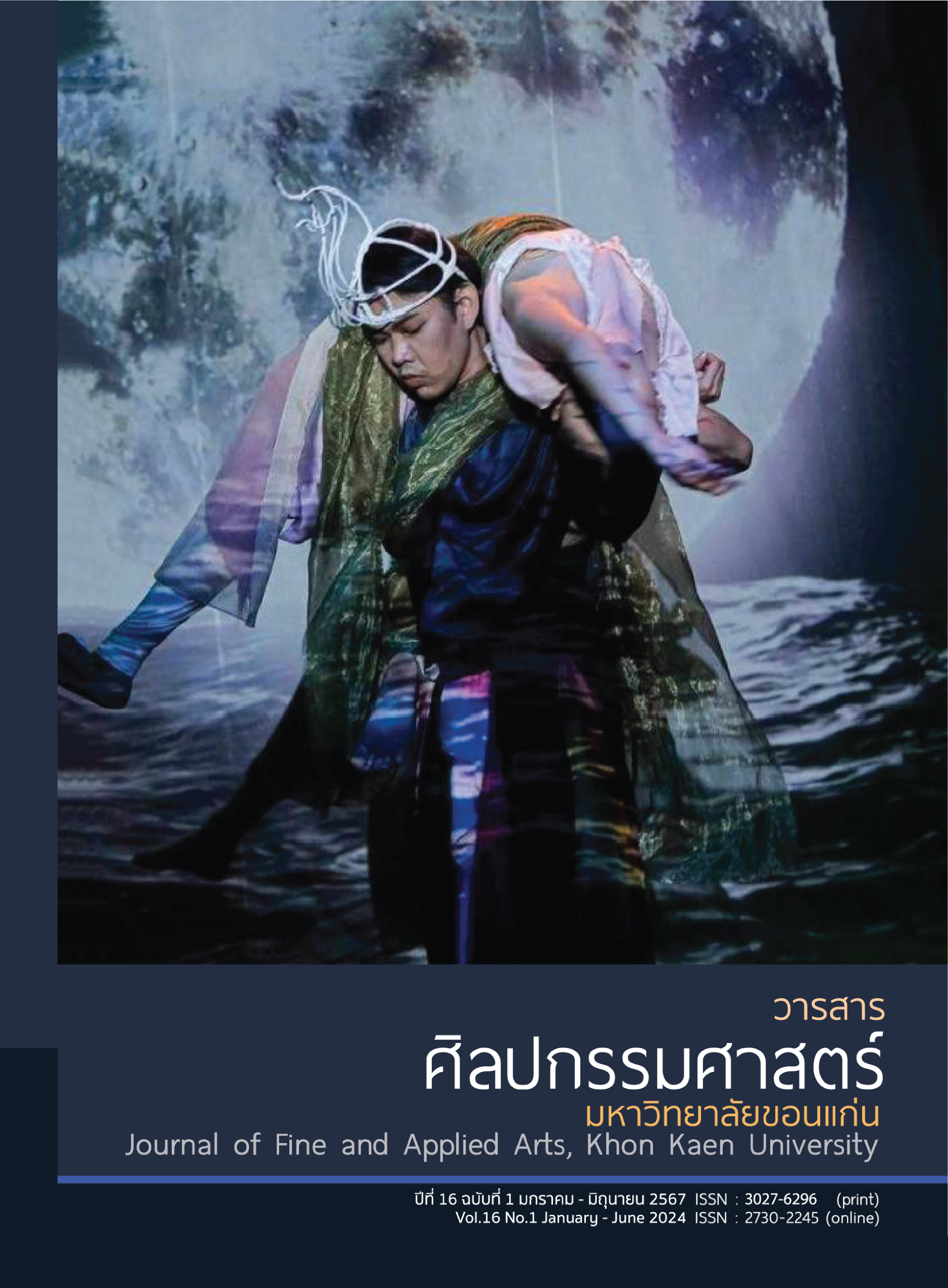Language Register in The Silence
Main Article Content
Abstract
This qualitative research employed textual analysis and in-depth interview methods along with data triangulation. The aim of this study was to analyse the language register in a film, The Silence (2019). The results revealed that the language register in this film could divided into 3 registers which were 1) sound register 2) crisis register and 3) religion register. All registers were useful in order to make characters and situations realistically, create unity and imitate code choices in human communication. Moreover, The silence was confirmed that environment and communication conditions are significant factors in terms of code choices for human beings.
Article Details

This work is licensed under a Creative Commons Attribution-NonCommercial-NoDerivatives 4.0 International License.
Content and information in articles published in the Journal of Fine and Applied Arts of Khon Kaen University is regarded as the opinion and sole responsibility of the author(s) directly; therefore, editors are not obliged to agree to or share any responsibility with regard to the content and information that appears within these articles.
All articles, information, content, image, etc. that have been published in the Journal of Fine and Applied Arts of Khon Kaen University is the copyright of the Journal of Fine and Appllied Arts of Khon Kaen University. Any person or organization who wishes to distribute all or parts of the articles for further dissemination or other usage must first receive permission from the Journal of Fine and Applied Arts of Khon Kaen University before proceeding to do so.
References
จรัญ กาญจนประดิษฐ์, จตุพร สีม่วง, ธรณัส หินอ่อน, วัศการก แก้วลอย, และวนิดา พรหมบุตร. (2564). ป้าตสะลาจ: สัทพจน์ทางดนตรีในคัมภีร์ในลานมอญ. วารสารไทยคดีศึกษา, 18(2), 147-168.
จีรนุช สมโชค. (2553). ประวัติของการควบคุมขนาดของครอบครัว: มุมมองของซีกโลกตะวันตก. วารสารวิทยาลัยพยาบาลบรมราชชนนี นครราชสีมา, 16(2), 15-21.
ณัฏฐา ระกำพล. (2562). วัจนลีลาในเพลงรำวงมาตรฐาน. วิทยานินพธ์ปริญญานิเทศศาสตรมหาบัณฑิต สาขานิเทศศาสตร์ คณะนิเทศศาสตร์ จุฬาลงกรณ์มหาวิทยาลัย.
ถิรนันท์ อนวัชศิริวงศ์. (2546). สุนทรียนิเทศศาสตร์ การศึกษาสื่อสารการแสดงและสื่อจินตคดี. กรุงเทพฯ :
โรงพิมพ์แห่งจุฬาลงกรณ์มหาวิทยาลัย.
ธวัช เวศตัน. (2563). การออกแบบในการสื่อสารภาวะวิกฤตของศูนย์บริหารสถานการณ์การแพร่ระบาดของโรคติดเชื้อไวรัสโคโรนา 2019 (ศบค.). วิทยานินพธ์ปริญญานิเทศศาสตรมหาบัณฑิต สาขานิเทศศาสตร์ คณะนิเทศศาสตร์ จุฬาลงกรณ์มหาวิทยาลัย.
ปนันดา เลอเลิศยุติธรรม. (2557). อุปลักษณ์ในทำเนียบภาษากฎหมาย ภาษาวิชาการ ภาษาการเมือง และภาษาสื่อของไทย. วารสารมนุษยศาสตร์ปริทรรศน์, 32(2), 73-84.
เปลื้อง ณ นคร. (2541). ศิลปะแห่งการประพันธ์ : หลักในการถ่ายทอดประสบการณ์ ความคิด และจินตนาการจากจิตสำนึก. กรุงเทพฯ : ข้าวฟ่าง.
รักศานต์ วิวัฒน์สินอุดม. (2546). นักสร้าง สร้างหนัง หนังสั้น. กรุงเทพฯ : โครงการตำราคณะนิเทศศาสตร์ จุฬาลงกรณ์มหาวิทยาลัย.
รักศานต์ วิวัฒน์สินอุดม. (2558). การเขียนบทภาพยนตร์บันเทิง. กรุงเทพฯ : โครงการตำราคณะนิเทศศาสตร์ จุฬาลงกรณ์มหาวิทยาลัย.
ราชบัณฑิตยสถาน. (2545). พจนานุกรมศัพท์วรรณกรรมอังกฤษ-ไทย. กรุงเทพฯ : อรุณการพิมพ์.
ราษฎร์ บุญญา. (2551). ภาษามือ: ภาษาของคนหูหนวก. วารสารวิทยาลัยราชสุดา, 4(1), 77-94.
สุจิตรา จงสถิตย์วัฒนา. (2549). เจิมจันทน์กังสดาล ภาษาวรรณศิลป์ในวรรณคดีไทย. พิมพ์ครั้งที่ 2. กรุงเทพฯ : โครงการเผยแพร่ผลงานวิชาการคณะอักษรศาสตร์ จุฬาลงกรณ์มหาวิทยาลัย.
สุรพงษ์ โสธนะเสถียร. (2561). สารกับการสื่อความหมาย. กรุงเทพฯ : แดเน็กซ์อินเตอร์คอร์ปอเรชั่น.
หริณวิทย์ กนกศิลปธรรม. (2556). ความหลากหลายทางเพศในมุมมองของจริยศาสตร์ศาสนาคริสต์และพุทธศาสนา. วารสารอักษรศาสตร์ มหาวิทยาลัยศิลปากร, 35(2), 101-122.
อมรา ประสิทธิ์รัฐสินธุ์. (2548). ภาษาในสังคมไทย ความหลากหลาย การเปลี่ยนแปลง การพัฒนา. พิมพ์ครั้งที่ 4. กรุงเทพฯ : โรงพิมพ์แห่งจุฬาลงกรณ์มหาวิทยาลัย.
Cambridge Academic Content Dictionary. (2017). 4th ed. Cambridge : Cambridge University Press.
Flick, U. (2014). An introduction to qualitative research. 5th ed. London : Sage.
Frandsen, F., & Johansen, W. (2017). Organizational crisis communication. London : Sage.
McKee, R. (1997). Story: Substance, structure, style, and the principles of screenwriting.
New York : Harper-Collins.
Merriam, S. B., & Tisdell, E. J. (2015). Qualitative research: A guide to design and implementation. 4th ed. San Francisco : Jossey-Bass.
Shannon, C. E., & Weaver, W. (1969). The mathematical theory of communication. Urbana : University of Illinois Press.
Sheehan, M., & Quinn-Allan, D. (2015). Crisis communication in a digital world. Cambridge : Cambridge University Press.
Thornborrow, J., & Wareing, S. (1998). Patterns in language. Oxon : Routledge.
Ulmer, R. R., Sellnow, T. L., & Seeger, M. W. (2015). Effective crisis communication: Moving from crisis to opportunity. California : Sage.
Ulrich, C. G. (1999). Deutungsmusteranalyse und diskursives Interview. Zeitschrift fur Soziologie, 28, 429-447.


